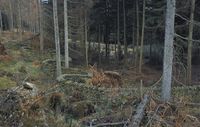"I take seriously the responsibility of leaving behind something that will last a long time."
"It is the mystery that makes such loveliness," wrote Barbara Hepworth of her sculpture, "I want to project my feeling about it into sculpture—not words." I read this compulsion into most things artists write; their words are secondary.
And yet, British sculptor Andy Goldsworthy (born July 26, 1956) wields natural elements such as ice, wood, stone, sand, and wind to create pieces that call attention to landscapes; he writes beautifully: “I take seriously the responsibility of leaving behind something that will last a long time.”
 Grizedale Wall, Cumbria, 1990. "There is tension between the trees and the wall. It will not remain as it is now."
Grizedale Wall, Cumbria, 1990. "There is tension between the trees and the wall. It will not remain as it is now." Goldsworthy constructs permanent and ephemeral works. The latter to push boundaries through experimentation, the former to create pieces that will endure and change.
"Very often, the discarded or the ephemeral or the thrown away can have a vital role in a collage. Something discarded has its own shape already that can be dropped into the mix."
The wall is one of Goldsworthy's most recognized and studied figures. In 1989, Goldsworthy constructed the "Wall that Went for a Walk" in his native Cumbria, a serpentine wall that hugs and encloses the landscape.
A decade later, he built a similar dry-stone sculpture, "Storm King Wall," in New York. The undertaking is captured in Wall. The experience inspired Goldsworthy to reflect on the difference between American and English concepts of "walls."
The nostalgic view of walls is a very American view because most of them have disappeared here. I still see walls as a vigorous and growing part of the landscape. I bring wallers with me from England and Scotland whose idea of a wall is work, and the idea of work is very important because it makes a strong link to agriculture.
[...]
I think the main difference between a design process and a sculptural process is that the latter is close to the way things grow. The large things I make don't arrive large as much American sculpture seems to have. The way my walls are made, stone upon stone, is like growth.
Sculptor Barbara Hepworth once discussed why she was drawn to carving rather than modeling. She preferred work that was extracted rather than formed. Goldsworthy's sculpture—created by adding piece by careful, considered piece —adds another dimension to this estimable art form.
At its heart, Goldsworthy's Wall is a dialogue of stone and wood, how the materials support or destroy each other. It is a study of how walls are built one piece at a time, culminating in a whole that is different from its parts.
Above all, it demonstrates Goldsworthy's attempt to capture in a wall what he feels from the stones: "I feel a powerful sense of flow and movement in stone—whether it has been shifted by geological forces or by people." Robust connectivity between material and sculpture renders the building and the decaying relevant.
The wall is not an object to be preserved in the traditional sense of art conservation. It is at the beginning of its life. What kind of life it has will depend on what happens to it. It has many possibilities.
 Storm King Wall, New York, 1997. "The most compressed part of the wall, where the trees grow closest together, is the heart of the sculpture and the place where there is the most tension."
Storm King Wall, New York, 1997. "The most compressed part of the wall, where the trees grow closest together, is the heart of the sculpture and the place where there is the most tension." Goldsworthy's body of work, over forty years, represents change, support, tension, trails, paths, and the connectedness of humans and nature.
"Sculpture can take on the quality of a design in the landscape," he writes in Wall, "and I make works that function at that level." The entwined cores of nature and man are a constant thread in the sublime poetry of Wendell Berry, an American who writes of nature's deep connectedness to humankind. And, of course, the early Romantic poets like Coleridge turned to heart and its trimmings as a metaphor for unspeakable emotions.
Goldsworthy's sculptural interest in walls, in particular, grows from the strong history of agricultural walls in England and an interest in things that self-delineate—a concept observed by poet Thomas A. Clark, who considered walking our natural form of self-delineation.
Goldsworthy sees the wall similarly.
The final destination of this wall was not known in the beginning. I enjoy a sculpture that has this sense of discovery and journey about it. Not knowing the final form or line at the beginning added richness to its making.
 Grizedale Wall, Cumbria, 1997. "Inevitably, the trees will cause the wall's collapse […] because of the sheer size of their trunks or because they are uprooted and crash onto it." Photograph by Andy Goldsworthy.
Grizedale Wall, Cumbria, 1997. "Inevitably, the trees will cause the wall's collapse […] because of the sheer size of their trunks or because they are uprooted and crash onto it." Photograph by Andy Goldsworthy.On the relationship between humans and landscape, pick up any of Robert Macfarlane's vital studies of how we interact and connect with the space around us. Using Goldsworthy's work as text, my article What Is a Wall? peers deeper into interpretations of this form that is so common and yet quite rich.

